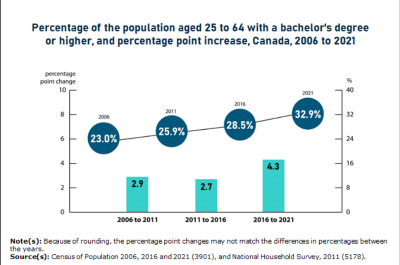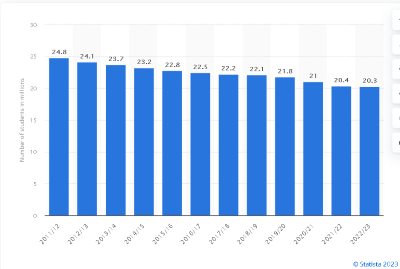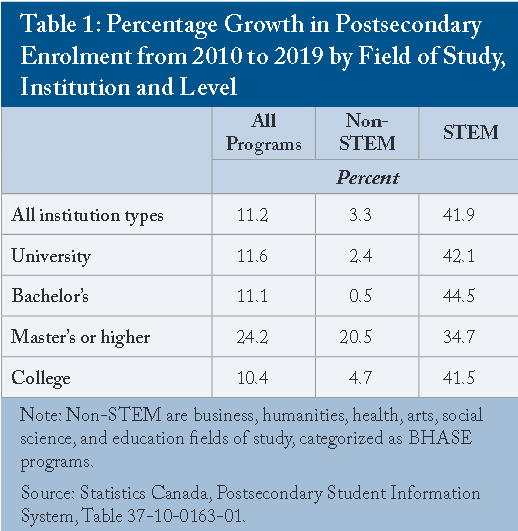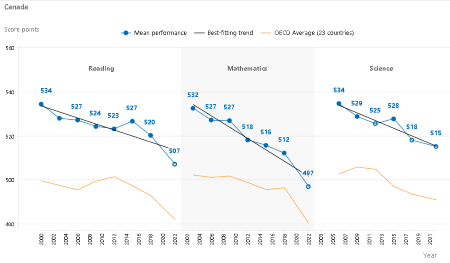Does Canada have enough STEM and IT talent for the knowledge economy?
.jpg) Peter Josty is Executive Director of the Centre for Innovation Studies in Calgary.
Peter Josty is Executive Director of the Centre for Innovation Studies in Calgary.
Having a skilled workforce is widely regarded as a key to economic growth and productivity. This is becoming increasingly important with the rise of the knowledge economy and technologies such as artificial intelligence and synthetic biology. How is Canada doing?
According to the Organisation for Economic Co-operation and Development (OECD), Canada has the highest proportion among the G7 nations of the 25-64 age group, at 57.5 per cent, with a college or university credential. The percentage of Canadians with a university degree has also been rising quite steeply. (See graph below. Source: Statistics Canada).

However not all groups in Canada are doing so well. In 2021, just over 50 per cent of First Nations people, Métis and Inuit had completed high school. This is an untapped resource.
While university and college enrollment has been going up in Canada, enrollment in the U.S. – our major trading partner – has been declining. (See graph below. Source: Statista). This is an ominous sign for Canada because it might increase our brain drain as U.S. firms seek skilled people elsewhere.
Undergraduate enrollment U.S. colleges and universities
 No one seems to have a definitive answer as to why enrolment in the U.S. is declining, but student debt is mentioned frequently. There is still a substantial salary benefit to getting more education in the U.S.
No one seems to have a definitive answer as to why enrolment in the U.S. is declining, but student debt is mentioned frequently. There is still a substantial salary benefit to getting more education in the U.S.
In a period when technology and digitalization is becoming more important, STEM skills will be critical for ensuring economic growth and productivity. It is encouraging to see that the number of STEM students in Canada has been rising much faster than students in other subjects. (See table below. Source: C. D. Howe Institute).
 However, there is a serious gender imbalance. According to Statistics Canada, women make up less than 25 per cent of people employed in STEM careers. This is similar to the U.S. but far less than Europe where women make up 43 per cent of the STEM workforce.
However, there is a serious gender imbalance. According to Statistics Canada, women make up less than 25 per cent of people employed in STEM careers. This is similar to the U.S. but far less than Europe where women make up 43 per cent of the STEM workforce.
This situation is slowly improving, but more slowly for women: 8.3 per cent of male high school graduates completed a bachelor’s degree STEM program, compared with 6.5 per cent of their female counterparts.
Ensuring the next generation has sufficient skills
Students currently in high school will be entering the workforce in the not too distant future. How skilled are they likely to be?
One source of information is the Programme for International Student Assessment (PISA), carried out by the OECD every three years. PISA tests 15-year-olds in mathematics, reading and science. Canada’s PISA scores have been declining since 2000, as have those of almost every other country. (See graphic below. Source: OECD).

The reasons for the worldwide decline don’t seem to be well understood. One anecdotal reason might be the decline in standardized testing, which is being replaced by teacher-assigned marks. A report from the Fraser Institute confirms the decline in standardized testing in Canada. Singapore, the highest rated country in the PISA results, has a highly competitive education system, as does China and other Asian countries that rate well. There is widespread use of private tutors.
Some critics have called for a return to standardized testing, arguing that such tests help lower-income and marginalized students.
Huge need for skilled tech talent
A headline in a story in The Globe and Mail says it all: “Demand for tech skills is soaring. Firms must offer reskilling programs to close the gap.” Businesses are struggling to find and retain skilled talent with the most in-demand tech employees being cloud computing specialists (41 per cent), those with an artificial intelligence/machine learning background (27 per cent), and security architects (25 per cent).
Other skills shortages include IT technicians (24 per cent), data analysis (24 per cent), data protection (24 per cent), and security analysts (24 per cent).
The federal government is also struggling to hire people with digital skills to upgrade its old information systems.
Future demand for STEM skills
A report by the C.D. Howe Institute paints a picture of a shortage of digital and STEM skills in the future. The report points to rapid digitalization across the economy and an aging population as reasons for the shortage. The report’s author, Parisa Mahboubi, senior policy analyst at the C. D. Howe Institute, makes several recommendations to improve the situation, including:
- increasing STEM enrollment and graduation numbers by raising students’ performance in STEM subjects, closing the STEM gender divide by better helping students to make study and career choices and encouraging under-represented groups to continue their education in STEM fields by identifying and addressing their particular needs.
- working with educational institutions to develop and expand digital skills learning, artificial intelligence and data science courses and programs.
- increasing high-quality work experience options such as work-integrated learning opportunities and expanding co-op programs in the information and communications technology sector.
- investing in reskilling and upskilling of the workforce.
- adapting the immigration system to increase the attraction and retention of immigrants with STEM and digital skills.
Conclusion
Canada faces a looming STEM skills shortage and this threatens the country’s future prosperity.
To improve this situation Canada needs to: encourage more students – particularly women – to take up STEM and IT careers; invest in reskilling and upskilling the workforce; and increase the attraction and retention of immigrants with STEM and IT skills. More attention also needs to be given to improving the education of First Nations people, Métis and Inuit who are currently considerably underrepresented.
The decline in university enrollment in the U.S. is a threat to Canada as it will increase the pressure for the brain drain of skilled people from Canada.
The decline in PISA scores in Canada is also concerning and more effort should be put into identifying and correcting the reasons for the decline.
R$
Events For Leaders in
Science, Tech, Innovation, and Policy
Discuss and learn from those in the know at our virtual and in-person events.
See Upcoming Events
You have 0 free articles remaining.
Don't miss out - start your free trial today.
Start your FREE trial Already a member? Log in
By using this website, you agree to our use of cookies. We use cookies to provide you with a great experience and to help our website run effectively in accordance with our Privacy Policy and Terms of Service.





.png)